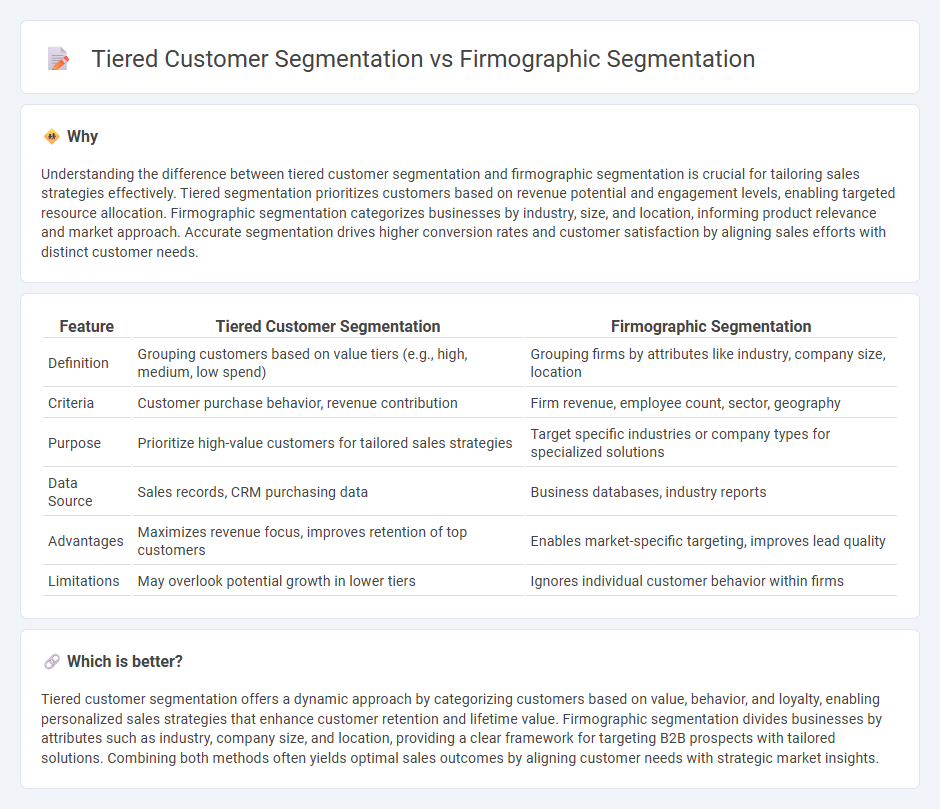
Tiered customer segmentation categorizes clients based on their purchasing behavior and value, enabling tailored sales strategies that maximize revenue from high-priority tiers. Firmographic segmentation organizes customers by company attributes such as industry, size, and location, facilitating targeted marketing campaigns that align with specific business profiles. Explore the advantages of both methods to refine your sales approach and boost conversion rates.
Why it is important
Understanding the difference between tiered customer segmentation and firmographic segmentation is crucial for tailoring sales strategies effectively. Tiered segmentation prioritizes customers based on revenue potential and engagement levels, enabling targeted resource allocation. Firmographic segmentation categorizes businesses by industry, size, and location, informing product relevance and market approach. Accurate segmentation drives higher conversion rates and customer satisfaction by aligning sales efforts with distinct customer needs.
Comparison Table
| Feature | Tiered Customer Segmentation | Firmographic Segmentation |
|---|---|---|
| Definition | Grouping customers based on value tiers (e.g., high, medium, low spend) | Grouping firms by attributes like industry, company size, location |
| Criteria | Customer purchase behavior, revenue contribution | Firm revenue, employee count, sector, geography |
| Purpose | Prioritize high-value customers for tailored sales strategies | Target specific industries or company types for specialized solutions |
| Data Source | Sales records, CRM purchasing data | Business databases, industry reports |
| Advantages | Maximizes revenue focus, improves retention of top customers | Enables market-specific targeting, improves lead quality |
| Limitations | May overlook potential growth in lower tiers | Ignores individual customer behavior within firms |
Which is better?
Tiered customer segmentation offers a dynamic approach by categorizing customers based on value, behavior, and loyalty, enabling personalized sales strategies that enhance customer retention and lifetime value. Firmographic segmentation divides businesses by attributes such as industry, company size, and location, providing a clear framework for targeting B2B prospects with tailored solutions. Combining both methods often yields optimal sales outcomes by aligning customer needs with strategic market insights.
Connection
Tiered customer segmentation and firmographic segmentation are connected through their shared goal of categorizing customers based on distinct criteria to optimize sales strategies. Tiered segmentation ranks customers by value or potential, while firmographic segmentation classifies businesses by attributes like industry, size, and location. Integrating both allows sales teams to target prioritized accounts with tailored approaches, enhancing conversion rates and revenue growth.
Key Terms
**Firmographic Segmentation:**
Firmographic segmentation categorizes businesses based on measurable attributes such as company size, industry, location, and revenue, enabling precise targeting and personalized marketing strategies. This method provides actionable insights for B2B marketers by identifying organizational characteristics that influence purchasing behavior and decision-making processes. Explore how firmographic segmentation can optimize your customer engagement and drive sales growth.
Industry
Firmographic segmentation categorizes companies based on attributes like industry, company size, and location to tailor marketing strategies effectively. Tiered customer segmentation prioritizes clients by their value or potential, often integrating firmographic data such as industry to assign tiers. Explore detailed insights to understand how each approach enhances targeted marketing within specific industries.
Company Size
Firmographic segmentation classifies companies based on attributes like industry, location, and particularly company size, allowing marketers to tailor strategies to small, medium, and large enterprises. Tiered customer segmentation structures clients into hierarchical levels, often prioritizing company size alongside factors such as revenue and strategic value to optimize resource allocation and engagement. Explore deeper insights on how focusing on company size in these segmentation methods can enhance targeted marketing effectiveness.
Source and External Links
7 Essential Elements of Firmographic Segmentation - Firmographic segmentation is the process of analysing B2B audiences and grouping them based on shared company characteristics such as industry, location, company size, status, performance, executive title, and sales cycle stage, allowing better-targeted marketing.
Firmographics - Wikipedia - Firmographics are characteristics used to segment organizations similarly to how demographics segment people, often including company size, industry, and location, serving as a foundational approach in B2B segmentation.
4 simple firmographic segmentation strategies to effectively target B2B customers - Firmographic segmentation divides companies into groups based on attributes like industry type, size, location, job titles, structure, and revenue to refine marketing and sales strategies efficiently and cost-effectively.
 dowidth.com
dowidth.com